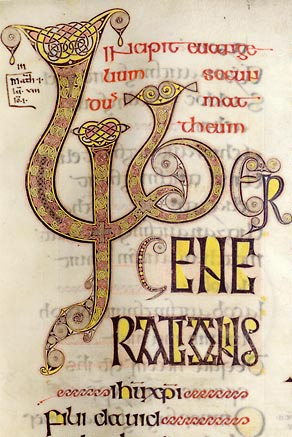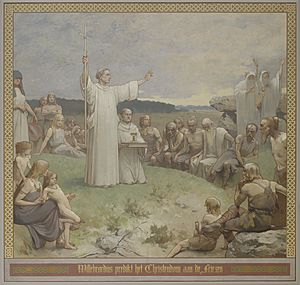Anglo-Saxon mission facts for kids

Anglo-Saxon missionaries were important people who helped spread Christianity in Europe during the 700s. They continued the work of earlier missionaries from Ireland and Scotland. These earlier missionaries had already spread Celtic Christianity in places like the Frankish Empire (which is now France and Germany), Scotland, and Anglo-Saxon England. Two key figures in the Anglo-Saxon mission were Ecgberht of Ripon and Ecgbert of York. Ecgberht helped organize the first missionaries like Wihtberht and Willibrord. Many later missionaries studied at York.
Contents
History of the Missions
Starting the Work
Ecgberht of Ripon had studied in Ireland. He started gathering monks to teach Christianity in a place called Frisia (part of modern-day Netherlands and Germany). Other important people, like Adalbert of Egmond and Chad of Mercia, were also involved. Ecgberht wanted to go himself, but a vision convinced him to stay.
Around the year 680 AD, Ecgberht sent Wihtberht, a noble Anglo-Saxon, to Frisia. But the local ruler, Redbad, King of the Frisians, was against it. So, Wihtberht was not successful and went back to England.
After this, Ecgberht planned a new mission with Willibrord and others. Pepin II, a powerful Frankish leader, wanted to expand his influence. He allowed Willibrord to travel freely to Rome. There, Willibrord was made a bishop for Frisia. This was a big step. It showed the first time the Carolingians (Pepin's family) and the Papacy (the Pope) worked together. This partnership helped the Anglo-Saxon missionaries a lot.
Saint Boniface's Efforts
One of the most famous missionaries was Saint Boniface. He worked in the area of Fulda (in modern Germany). He helped set up or restart many important church areas called bishoprics. These included places like Erfurt, Würzburg, and Büraburg. He also helped establish bishoprics in Eichstätt, Regensburg, Augsburg, Freising, Passau, and Salzburg by 739.
Boniface had taught at a monastery school in England. He first went to Europe in 716. He joined Willibrord in Utrecht, who had been working with the Frisians since the 690s. However, a war between Charles Martel and Redbad, King of the Frisians stopped their work. Willibrord went to a monastery he had started, and Boniface returned to England. The next year, Boniface went to Rome. Pope Gregory II then sent him out as a traveling missionary bishop for Germania.
Boniface encouraged monks from England to join the missions. He reminded them that the people they were helping were like their own family. These missions, powered by the strong English church, spread south and east. Soon, the Anglo-Saxon missionaries met the Pippinids, the powerful ruling family in the Frankish lands.
Other Important Missionaries
Other Anglo-Saxon missionaries who went to Europe included Lebuin, Ewald, and Suidbert.
Saint Walpurga (Walburga) and her brothers, Saint Willibald and Saint Winibald, also helped Boniface. Willibald founded the Heidenheim monastery.
Monasteries and Their Role
Anglo-Saxon monasteries built in Europe were sometimes run by families. The first monastery started by Anglo-Saxons in Europe was Willibrord's Abbey of Echternach in 698. It was built on land given to him by a daughter of Dagobert II. Later, a writer named Alcuin said that Willibrord's successor, Aldberct, was a relative. Beornrad, who became the third abbot in 775, was also related to Willibrord and Alcuin. Even when Beornrad became an archbishop, he still led Echternach. This shows how Willibrord's family managed the abbey for its first 100 years.
Willehad was born in England and likely studied in York. He started his missionary work with the Frisians around 766. In 780, Charlemagne sent him to preach in the Weser River area and later among the Saxons. After a Saxon rebellion in 782, Willehad continued his work from Echternach. He later became the bishop of Bremen. People believed that Willehad was also related to Beornrad.
Lasting Impact
Anglo-Saxon missionary work continued into the 770s, during the rule of Charlemagne. The Anglo-Saxon scholar Alcuin played a big part in the Carolingian Renaissance, a time of great learning. By the year 800, the Carolingian Empire was mostly Christian. After this, new missionary work, like spreading Christianity in Scandinavia and the Baltic Sea area, was managed directly from the Holy Roman Empire, not from England.
J. R. R. Tolkien, a famous writer, said that the Anglo-Saxon mission was "one of the chief glories of ancient England." He believed it was one of England's most important contributions to Europe.
See also
- Christianization of the Germanic peoples


